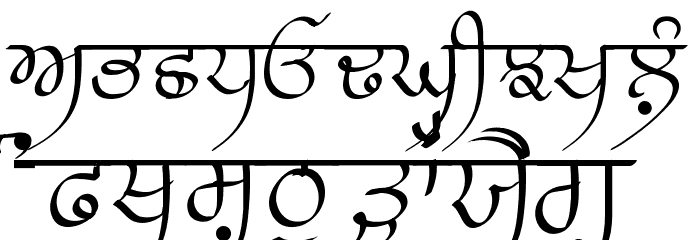

In the glyph sequence, the below-base form comes after the consonant(s) that form the base glyph. Layout operations are defined in terms of a base glyph, not a base character, since the base can often be a ligature.īelow-base form of consonants - A variant form of a consonant that appears below the base glyph. In "degenerate" syllables that have no vowel (last letter of a word), the last consonant in halant form serves as the base consonant and is mapped as the base glyph. In Gurmukhi, the last consonant of the syllable usually forms the base glyph. Akhand ligatures may be displayed in either half- or full-form.īase glyph - The only consonant or consonant conjunct in the orthographic syllable that is written in its "full" (nominal) form. Akhand ligatures have the highest priority and are formed first some languages include them in their alphabets. The following terms are useful for understanding the layout features and script rules discussed in this document.Ībove-base form of consonants - A variant form of a consonant that appears above the base glyph.Īkhand ligatures - Required consonant ligatures that may appear anywhere in the syllable, and may or may not involve the base glyph. Thus, the shaping engine will treat it as a half form and the I-matra will be positioned immediately in front of the "half-form" K(a). Option 2: While the Ka does not have a true half form in Gurmukhi, it can be listed in the 'half' feature lookup substituting the 'halant form' of Ka. Option 1: (default results) because the Ka is not listed in the half feature the shaping engine treats the Ka as the first main consonant and re-orders the I-matra immediately in front of the previous base consonant. The Indic shaping engine always re-orders a pre-pended matra immediately in front of the previous base consonant (or half form, if there is one). While there are no half-forms in Gurmukhi, the half feature is made available for typographic preferences.

For example, the location where pre-pended matras and the reph (in scripts like Devanagari) are re-ordered within a syllable cluster is affected by the presence of a half form.

The new Indic shaping engine allows for variations in typographic conventions, giving a font developer control over shaping by the choice of designation of glyphs to certain OpenType features. In addition, registered features of the Gurmukhi script are defined and illustrated with examples.

While it does not contain instructions for creating Gurmukhi fonts, it will help font developers understand how the Indic shaping engine processes Indic text. It contains information about terminology, font features and behavior of the Indic shaping engine in regards to the Gurmukhi script. This document targets developers implementing Indic shaping behavior compatible with Microsoft OpenType specification for Indic scripts. Gurmukhi is used to write the Punjabi language in the Punjab in India. This document presents information that will help font developers create or support OpenType fonts for the Gurmukhi script covered by the Unicode Standard.
Buy gurmukhi font update#
While Indic fonts made according to the earlier recommendations will still function properly in new versions of Uniscribe, font developers may wish to update their fonts, particularly if they wish to avoid certain limitations of the earlier implementation. Please note: This document reflects the changes made in 2005 for recommendations for Indic-script OpenType font and shaping-engine implementations.


 0 kommentar(er)
0 kommentar(er)
